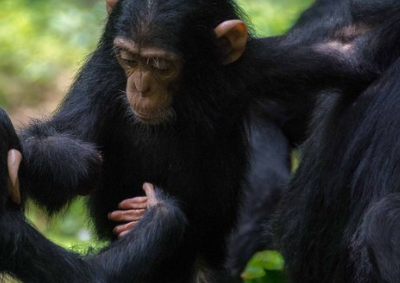Chimpanzees, much like humans, engage in rapid and intricate face-to-face communication, as revealed by a new study. While chimps primarily use gestures rather than vocalizations, their exchanges are quick and reflect cultural differences similar to those seen in human conversations. The study observed wild East African chimpanzees, noting that responses often occurred within a second, with some reactions being almost instantaneous, resembling human conversational interruptions.
Lead author Gal Badihi, an ethologist from the University of St Andrews in the UK, explains that the similarity in the speed of chimpanzee gestures and human turn-taking suggests that similar evolutionary mechanisms may drive these interactions. This indicates that the roots of our communication style could date back to a common ancestor of humans and chimps millions of years ago.
Chimpanzees gesture in “turn-taking” fashion, similar to human communication. CARTA friends, Fiona Stewart and Alex Piel, were involved in this new research. https://t.co/AuRw0RVQkt
— UCSD-CARTA (@CARTAUCSD) July 26, 2024
The research team analyzed over 8,500 instances of gestures from 252 chimps, discovering not only parallels to human communication patterns but also cultural variations within chimp communities. For example, Uganda’s Kanyawara chimpanzees were observed to ‘talk’ faster compared to the Sonso chimpanzees in the nearby Budongo Forest. This mirrors human cultural differences, such as the Danish being known for slower conversational pacing compared to other cultures.
Chimpanzees, like humans, combine gestures to form longer sequences of meaning, akin to how words are used to construct sentences. Researchers have already identified 58 different ‘let’s play’ gestures used by chimps. These gestures help them avoid conflicts and coordinate social interactions, such as requesting food or reestablishing peace after a dispute.
For instance, after a physical altercation, a chimp named Monica extended her hand towards another chimp, Ursus, who responded with a reassuring tap, highlighting the role of gestures in maintaining social harmony.
New research story on NPR: What chimpanzee gestures reveal about human communication https://t.co/nlg7HPDwsJ
— seventhsci (@seventhsci) July 26, 2024
Despite the clear differences between chimp and human languages, the study suggests that both systems follow similar underlying rules. The researchers are now interested in exploring communication in other highly social species, like elephants and ravens, to determine whether these conversational structures are unique to apes or shared across different species.
Key Points:
- Chimpanzee communication is as rapid and complex as human conversation, with responses often occurring within a second.
- The study found cultural variations in communication speed among different chimp communities, similar to differences seen in human cultures.
- Chimpanzees use gestures to communicate complex messages, combining them to form sequences much like human sentences.
- The gestures help chimps avoid conflicts and coordinate social interactions, such as requesting food or reestablishing peace.
- Researchers are interested in exploring whether these conversational structures are unique to apes or shared with other social species.
James Kravitz – Reprinted with permission of Whatfinger News







